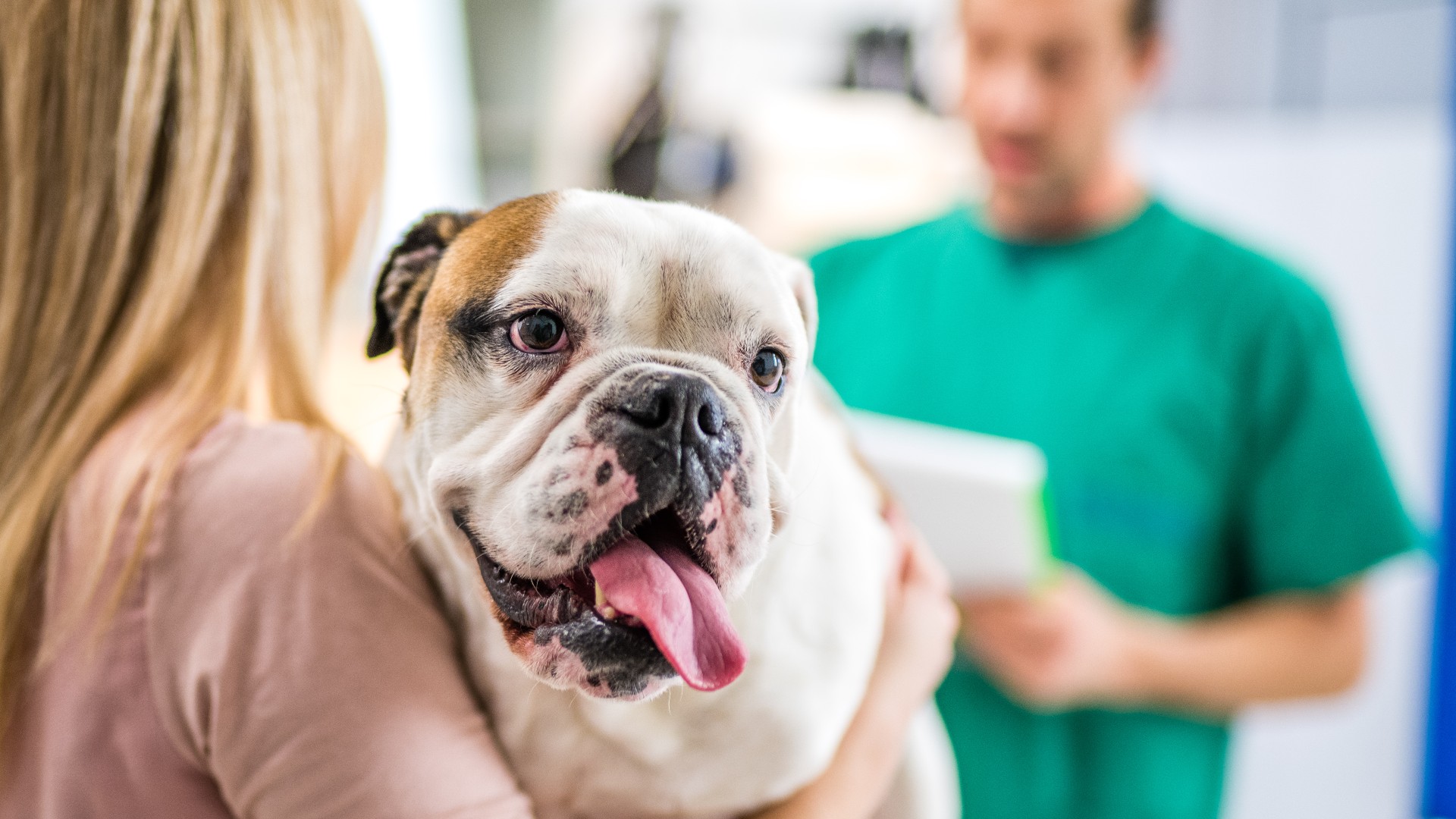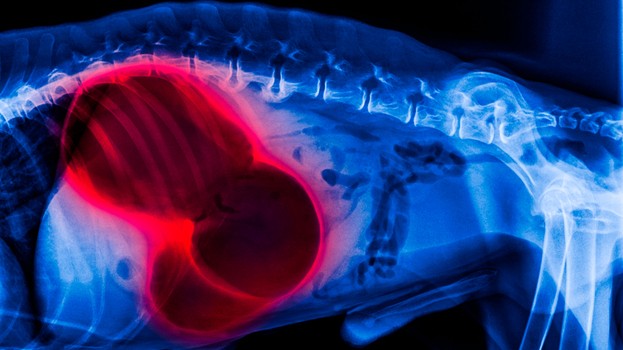What is bloat in dogs? A vet's guide
What is bloat in dogs? We reveal everything you need to know about this life-threatening emergency that requires immediate veterinary attention

Bloat in dogs is an extremely serious disease of the stomach that makes our canine companions sick very suddenly and can be fatal. Caused by excess gas, fluid or your pup wolfing down their bowl of the best dog food too quickly, this life-threatening condition requires an immediate trip to the vet.
While it might not sound like it would be all that costly, bloat can be very expensive to treat, so investing in the right pet insurance can ensure that you’re prepared for emergency situations such as this. Let’s take a closer look at what bloat is and how it is managed.
What is bloat in dogs?
Bloat, or gastric dilatation-volvulus (GDV), is a canine condition in which the stomach fills with gas, fluid, or food and twists on its axis, compressing vital blood vessels in the abdomen. This cuts off blood supply to the stomach and prevents blood in the abdomen from returning to the heart. A flipped stomach can also sometimes take the spleen and pancreas with it, cutting off their blood supply. This can cause necrosis of the stomach wall and spleen, a buildup of toxins in the blood, and shock.
GDV can be fatal within hours if left untreated, so this condition is always an emergency. It often develops without any warning, and it can progress quickly.
Some dogs develop gastric dilatation, where the stomach is distended without flipping. Although this condition might resolve on its own, it can progress to GDV and therefore also requires veterinary attention.
What causes bloat in dogs?
No specific cause of GDV has been identified, but there are several risk factors thought to contribute to its development:
- Breed: Several dog breeds have an increased risk of developing GDV, including Great Danes, Irish Setters, and German Shepherds, among others. In fact, the American Kennel Club states that an estimated 37% of Great Danes will develop GDV in their lifetime. In addition, a study published in Canine Medicine and Genetics found that GDV was more prevalent in purebred dogs than in mixed-breed dogs. It is important to note, however, that bloat can develop in any breed.
- Size and shape: Dogs that are taller than they are wide with deep chests are more likely to develop bloat, which explains many of the breed predispositions. Higher body weight and leaner body condition are also associated with an increased risk.
- Increased age: Although it can occur at any age, bloat is most commonly seen in middle-aged dogs.
- Genetics: Dogs who have a family history of GDV are more likely to develop it themselves. For this reason, these dogs should not be bred.
- Eating or drinking a large amount: Many dogs who develop GDV do so after consuming a large meal or drink of water. In addition, a scientific study found that large and giant-breed dogs fed a large meal once a day were more likely to develop GDV than those fed 2 meals a day.
- Exercise after a meal: Exercise after eating increases the risk of GDV, so it is recommended that high-risk breeds are given at least 1-2 hours to relax after mealtime.
- Diet: A 2006 study found that diets containing oil or fat as one of the first four ingredients increased the risk of GDV. Another study from 1998 discovered that Great Danes fed smaller-sized kibble were more likely to develop bloat.
- Stress: Stressed or hyperactive dogs are more likely to develop GDV.
Symptoms of bloat in dogs
Symptoms of GDV include:
Get the best advice, tips and top tech for your beloved Pets
- Acute, non-productive retching, sometimes bringing up white foam
- Restlessness or pacing, often accompanied by distress
- Abdominal pain, which can sometimes be noted by dogs assuming the “prayer position” (i.e., front half down, bottom half up)
- Abdominal distension, due to increased gas in the stomach (which may have a tympanic sound when tapped) and blood accumulating in the abdomen
- Rapid heart rate
- Panting
- Hypersalivation
- Pale gums
- Collapse
Dogs showing any of these signs should be taken to a veterinarian immediately.

How is bloat diagnosed in dogs?
Bloat can be diagnosed with a single X-ray of the abdomen, which will reveal whether the stomach is distended and if it has flipped. The veterinarian will also perform bloodwork to help determine the severity of the dog’s condition.
What is the treatment for bloat in dogs?
The immediate treatment of bloat involves aggressive intravenous fluids and decompression of the stomach to stabilize the dog before surgery. Antibiotics are also started to prevent infection following possible necrosis of the stomach and spleen.
GDV is a surgical emergency that cannot be managed with medications alone. Surgery is performed to untwist the stomach and determine the disease severity. Any tissues that have died must be removed, so many dogs require resection of necrotic stomach mucosa and/or removal of the spleen. The operating vet will also perform a gastropexy, where the stomach is sutured to the abdominal wall to keep it in place and prevent recurrence. The dog will require postoperative hospitalization, often for several days.
In cases of gastric dilatation without volvulus/twisting, dogs are typically hospitalized for fluid therapy and medications, and they are walked frequently to stimulate gas movement through the gastrointestinal tract.
Prognosis of bloat in dogs
The overall mortality rate of GDV is estimated to be between 10% and 27%. Several factors influence prognosis, including how quickly the patient receives veterinary care and how extensive the damage is to the stomach. Euthanasia may be recommended in cases where a significant amount of the stomach has died.
Gastropexy markedly reduces the risk of recurrence in GDV. A Scandinavian study found that half of the dogs who did not receive a gastropexy during GDV surgery experienced recurrence within 6 months. Gastropexy does not, however, reduce the risk of gastric dilatation.
What is the timeline of bloat in dogs?
GDV progresses extremely quickly, and affected dogs can go into shock and even die within a few hours of their symptoms appearing. For this reason, if your dog is showing any signs of bloat, they should be taken to a veterinarian immediately for assessment—this may be crucial in saving their life.
Dr. Diana Hasler graduated with distinction from the University of Edinburgh Royal (Dick) School of Veterinary Studies in 2018. She has experience working as a small animal veterinarian in general practice, where she has treated many dogs, cats, rabbits, and rodents. She has also recently branched out into the field of medical communications, doing freelance work as a medical editor and writer. Dr. Hasler has been Postdoctoral Research Fellow at Michigan Medicine since 2023, where she is a Laboratory Animal Medicine Resident.

